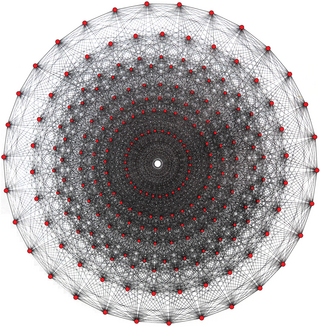The configuration matrix is:[3]
![{\displaystyle \left[{\begin{smallmatrix}240&27&72&27\\3&2160&8&8\\8&8&2160&3\\27&72&27&240\end{smallmatrix}}\right]}](//wikimedia.org/api/rest_v1/media/math/render/svg/8c7dcd1aaf99fa519c4740d6d553ab0f4445980b)
The number of vertices, edges, faces, and cells are seen in the diagonal of the matrix. These are computed by the order of the group divided by the order of the subgroup, by removing certain complex reflections, shown with X below. The number of elements of the k-faces are seen in rows below the diagonal. The number of elements in the vertex figure, etc., are given in rows above the digonal.
Its 240 vertices are given coordinates in  :
:
- (0, ±ωμ, -±ων, ±ωλ)
- (-±ωμ, 0, ±ων, ±ωλ)
- (±ωμ, -±ων, 0, ±ωλ)
- (-±ωλ, -±ωμ, -±ων, 0)
|
- (±iωλ√3, 0, 0, 0)
- (0, ±iωλ√3, 0, 0)
- (0, 0, ±iωλ√3, 0)
- (0, 0, 0, ±iωλ√3)
|
where  .
.
The last 6 points form hexagonal holes on one of its 40 diameters. There are 40 hyperplanes contain central 3{3}3{4}2, 



 figures, with 72 vertices.
figures, with 72 vertices.
Coxeter named it after Alexander Witting for being a Witting configuration in complex projective 3-space:[4]
![{\displaystyle \left[{\begin{smallmatrix}40&12&12\\2&240&2\\12&12&40\end{smallmatrix}}\right]}](//wikimedia.org/api/rest_v1/media/math/render/svg/4595e36b413dfbbc2e0c6a9a1047030a40375f04) or
or ![{\displaystyle \left[{\begin{smallmatrix}40&9&12\\4&90&4\\12&9&40\end{smallmatrix}}\right]}](//wikimedia.org/api/rest_v1/media/math/render/svg/fc42b73d1cf1ba3aa154d93c64392f36bb489074)
The Witting configuration is related to the finite space PG(3,22), consisting of 85 points, 357 lines, and 85 planes.[5]
Coxeter Regular Convex Polytopes, 12.5 The Witting polytope
Coxeter, Complex Regular Polytopes, p.134
Coxeter, Complex Regular polytopes, p.132
Alexander Witting, Ueber Jacobi'sche Functionen kter Ordnung Zweier Variabler, Mathemematische Annalen 29 (1887), 157-70, see especially p.169
Coxeter, Complex regular polytopes, p.133
Coxeter, Complex Regular Polytopes, p.134
Coxeter, Complex Regular Polytopes, p.135
Coxeter Regular Convex Polytopes, 12.5 The Witting polytope
- Coxeter, H. S. M. and Moser, W. O. J.; Generators and Relations for Discrete Groups (1965), esp pp 67–80.
- Coxeter, H. S. M.; Regular Complex Polytopes, Cambridge University Press, second edition (1991). pp. 132–5, 143, 146, 152.
- Coxeter, H. S. M. and Shephard, G.C.; Portraits of a family of complex polytopes, Leonardo Vol 25, No 3/4, (1992), pp 239–244
![]()
![]()
![]()
![]()
![]()
![]()
![]() . It has 240 vertices, 2160 3{} edges, 2160 3{3}3 faces, and 240 3{3}3{3}3 cells. It is self-dual. Each vertex belongs to 27 edges, 72 faces, and 27 cells, corresponding to the Hessian polyhedron vertex figure.
. It has 240 vertices, 2160 3{} edges, 2160 3{3}3 faces, and 240 3{3}3{3}3 cells. It is self-dual. Each vertex belongs to 27 edges, 72 faces, and 27 cells, corresponding to the Hessian polyhedron vertex figure.


![{\displaystyle \left[{\begin{smallmatrix}240&27&72&27\\3&2160&8&8\\8&8&2160&3\\27&72&27&240\end{smallmatrix}}\right]}](http://wikimedia.org/api/rest_v1/media/math/render/svg/8c7dcd1aaf99fa519c4740d6d553ab0f4445980b)


![{\displaystyle \left[{\begin{smallmatrix}40&12&12\\2&240&2\\12&12&40\end{smallmatrix}}\right]}](http://wikimedia.org/api/rest_v1/media/math/render/svg/4595e36b413dfbbc2e0c6a9a1047030a40375f04)
![{\displaystyle \left[{\begin{smallmatrix}40&9&12\\4&90&4\\12&9&40\end{smallmatrix}}\right]}](http://wikimedia.org/api/rest_v1/media/math/render/svg/fc42b73d1cf1ba3aa154d93c64392f36bb489074)